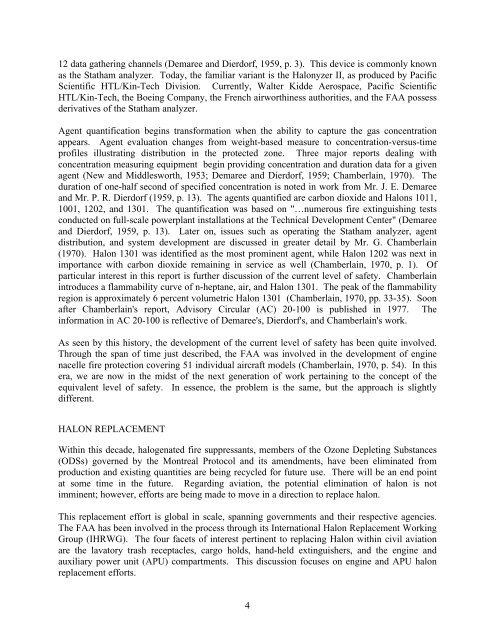FAA Engine Compartment Halon Replacement Project Background ...
FAA Engine Compartment Halon Replacement Project Background ...
FAA Engine Compartment Halon Replacement Project Background ...
Create successful ePaper yourself
Turn your PDF publications into a flip-book with our unique Google optimized e-Paper software.
12 data gathering channels (Demaree and Dierdorf, 1959, p. 3). This device is commonly known<br />
as the Statham analyzer. Today, the familiar variant is the <strong>Halon</strong>yzer II, as produced by Pacific<br />
Scientific HTL/Kin-Tech Division. Currently, Walter Kidde Aerospace, Pacific Scientific<br />
HTL/Kin-Tech, the Boeing Company, the French airworthiness authorities, and the <strong>FAA</strong> possess<br />
derivatives of the Statham analyzer.<br />
Agent quantification begins transformation when the ability to capture the gas concentration<br />
appears. Agent evaluation changes from weight-based measure to concentration-versus-time<br />
profiles illustrating distribution in the protected zone. Three major reports dealing with<br />
concentration measuring equipment begin providing concentration and duration data for a given<br />
agent (New and Middlesworth, 1953; Demaree and Dierdorf, 1959; Chamberlain, 1970). The<br />
duration of one-half second of specified concentration is noted in work from Mr. J. E. Demaree<br />
and Mr. P. R. Dierdorf (1959, p. 13). The agents quantified are carbon dioxide and <strong>Halon</strong>s 1011,<br />
1001, 1202, and 1301. The quantification was based on "…numerous fire extinguishing tests<br />
conducted on full-scale powerplant installations at the Technical Development Center" (Demaree<br />
and Dierdorf, 1959, p. 13). Later on, issues such as operating the Statham analyzer, agent<br />
distribution, and system development are discussed in greater detail by Mr. G. Chamberlain<br />
(1970). <strong>Halon</strong> 1301 was identified as the most prominent agent, while <strong>Halon</strong> 1202 was next in<br />
importance with carbon dioxide remaining in service as well (Chamberlain, 1970, p. 1). Of<br />
particular interest in this report is further discussion of the current level of safety. Chamberlain<br />
introduces a flammability curve of n-heptane, air, and <strong>Halon</strong> 1301. The peak of the flammability<br />
region is approximately 6 percent volumetric <strong>Halon</strong> 1301 (Chamberlain, 1970, pp. 33-35). Soon<br />
after Chamberlain's report, Advisory Circular (AC) 20-100 is published in 1977. The<br />
information in AC 20-100 is reflective of Demaree's, Dierdorf's, and Chamberlain's work.<br />
As seen by this history, the development of the current level of safety has been quite involved.<br />
Through the span of time just described, the <strong>FAA</strong> was involved in the development of engine<br />
nacelle fire protection covering 51 individual aircraft models (Chamberlain, 1970, p. 54). In this<br />
era, we are now in the midst of the next generation of work pertaining to the concept of the<br />
equivalent level of safety. In essence, the problem is the same, but the approach is slightly<br />
different.<br />
HALON REPLACEMENT<br />
Within this decade, halogenated fire suppressants, members of the Ozone Depleting Substances<br />
(ODSs) governed by the Montreal Protocol and its amendments, have been eliminated from<br />
production and existing quantities are being recycled for future use. There will be an end point<br />
at some time in the future. Regarding aviation, the potential elimination of halon is not<br />
imminent; however, efforts are being made to move in a direction to replace halon.<br />
This replacement effort is global in scale, spanning governments and their respective agencies.<br />
The <strong>FAA</strong> has been involved in the process through its International <strong>Halon</strong> <strong>Replacement</strong> Working<br />
Group (IHRWG). The four facets of interest pertinent to replacing <strong>Halon</strong> within civil aviation<br />
are the lavatory trash receptacles, cargo holds, hand-held extinguishers, and the engine and<br />
auxiliary power unit (APU) compartments. This discussion focuses on engine and APU halon<br />
replacement efforts.<br />
4
















